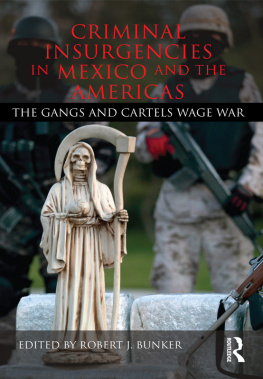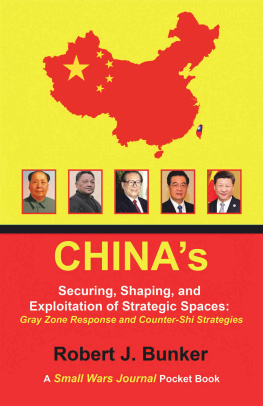SUMMARY
WHILE THE STUDY OF insurgency extends well over 100 years and has its origins in the guerrilla and small wars of the 19th century and beyond, almost no cross modal analysisthat is, dedicated insurgency form typology identificationhas been conducted. Until the end of the Cold War, the study of insurgency focused primarily on separatist and Marxist derived forms with an emphasis on counterinsurgency practice aimed at those forms rather than on identifying what differences and interrelationships existed. The reason for this is that the decades-long Cold War struggle subsumed many diverse national struggles and tensions into a larger paradigm of conflicta free, democratic, and capitalist West versus a totalitarian, communist, and centrally planned East.
With the end of the Cold War and the resulting ideological and economic implosion of the Soviet Union, post-Cold War insurgency typologies began to emerge because a need existed to understand where this component of the new global security environment was heading. Over 2 decades of research and writing have been focused on this endeavor by what is a relatively small number of insurgency practitioners and/or theorists. In addition, the works of some contemporary terrorism scholars are also relevant to this topical area of focus.
For this monograph to identify what can be considered new forms of insurgency that are developing, an appreciation for and understanding of earlier insurgency forms must also be articulated. With these thoughts in mind, this monograph will initially discuss what an insurgency is and some Western viewpoints on it, describe how terrorism analysis can potentially serve an indications and warnings (I&W) function, provide a literature review of the post-Cold War insurgency typologies that exist, create a proposed insurgency typology divided into legacy, contemporary, and emergent and potential insurgency forms, and finally provide strategic implications for U.S. defense policy as they relate to each of these forms. The work will also utilize a number of tables for organizational purposes and an endnotes section for scholarly citation requirements.
Pertaining to the insurgency and terrorism literature reviews conducted in this manuscript, the following terrorism and insurgency formsform name(s), author(s), and year of publicationwere analyzed in creating the final forms typology.
TERRORISM FORMS.
Anarchist, anti-colonial, new-left, religious extremism (Rapoport, 2001)
Utopian vision (Kaplan, 2007)
Ethnic, religious, ideological (Schnabel and Gunaratna, 2006, 2015)
INSURGENCY FORMS.
Commercial and spiritual (Metz, 1993)
Peoples war, Cuban-style focquismo, urban insurrection (Metz, 1993)
Defensive (Cable, 1993 in Metz, 1995)
Reactionary, subversive (camouflaged) (Metz,
1995)
Liberation, separatist, reform, warlord (Clapham, 1998)
Apolitical (Sloan, 1999)
Economic (Thom, 1999)
Resource-based (Cilliers, 2000)
Revolutionary warfare, wars of national liberation, urban, superpower (Beckett, 2001)
Globalized Islamist (Kilcullen, 2004)
National, liberation (Metz and Millen, 2004)
Anarchist, egalitarian, traditionalist (reactionary-traditionalist), apocalyptic-utopian, secessionist, reformist, preservationist, commercial (Metz, 1993; ONeill, 2005)
Virtual (Thomas, 2006)
Virtual (Hammes, 2007 in Metz, 2007)
Criminal (Sullivan, 2008)
Violent new religious movements (Lauder, 2009)
Urban (Sullivan and Elkus, 2009)
Resource control (Tarr, 2011)
Revolution, separatism, resistance (Jones, 2011)
Virtual (Sloan, 2011)
Plutocratic (Bunker, 2011)
Proto-state, nonpolitical, state destruction (Metz, 2012)
Urban (Kilcullen, 2013)
Chinese state (Jones and Johnson, 2013)
Singularity (Rectenwald, 2013)
Radical Christian (Metz, 2015)
Derived from this analysis, the following insurgency forms with their starting dates in ( ) have been identified as well as the strategic implications of each form for U.S. defense policy.
LEGACY INSURGENCY FORMS.
Anarchist(1880s). Generally violent, anarchism has only been viewed as a form of terrorism (Rapoport, 2001) because the end state sought is governmental even statedestruction. No replacement government or seizure of the state is being attempted nor is any form of subversion or co-option of state institutions or the parallel building of a shadow state taking place. Still, ONeill (2005) designates this as an insurgency form and the insurgency outcome of state-destruction exists in a later typology created by Metz (2012).
Strategic implications: None. This legacy insurgency form is an anachronism with the threat potentials downgraded to that of sporadic periods of local unrest being generated by protesters outside of political conventions and financial summits and characterized by vandalism, aggravated assault, and arson. This is solely a U.S. domestic law enforcement issue focusing on riot control, investigation of criminal activities, and limited counterterrorism response. No U.S. military response is required.
SeparatistInternalandExternal (1920s). This insurgency form encompasses both separation from local authoritysuch as the original Irish Republican Army (IRA) gaining Irish independence from the United Kingdom in 1921and the separation from foreign authority as took place in numerous regions during the decolonial period after the Second World War. Numerous theorists have identified this insurgency form, ranging from Cables (1993) defensive articulation through a number of others into Joness (2011) separatist and resistance types.
Strategic implications: Limited. This insurgency form now takes place only sporadically and to some extent has been replaced by more traditional secession ballot initiatives as have or may be seen in the future as taking place in Scotland, Catalonia, Flanders, and other locales. Still, the insurgencies of the 1990s that took place in the former Yugoslavia and the more recent secession of South Sudan in 2011 suggest this legacy form has not faded away. A possible U.S. military response may be required depending on the specific international incident taking place.
MaoistPeoples(1930s). The most identifiable insurgency form is derived from Mao Zedongs principles found in his 1937 work, OnGuerrillaWarfare. This form, also known as peoples war, utilizes peasant armies that are drawn upon for an integrated and protracted politico-military phase strategy of eventual state takeover. A shadow or proto-state is created in parallel to the pre-existing one being targeted for elimination. This form has been identified by Metz (1993) as peoples war, by Beckett (2001) as revolutionary warfare, by ONeill (2005) as egalitarian, and Schnabel and Gunaratna (2006; 2015) as ideological.













